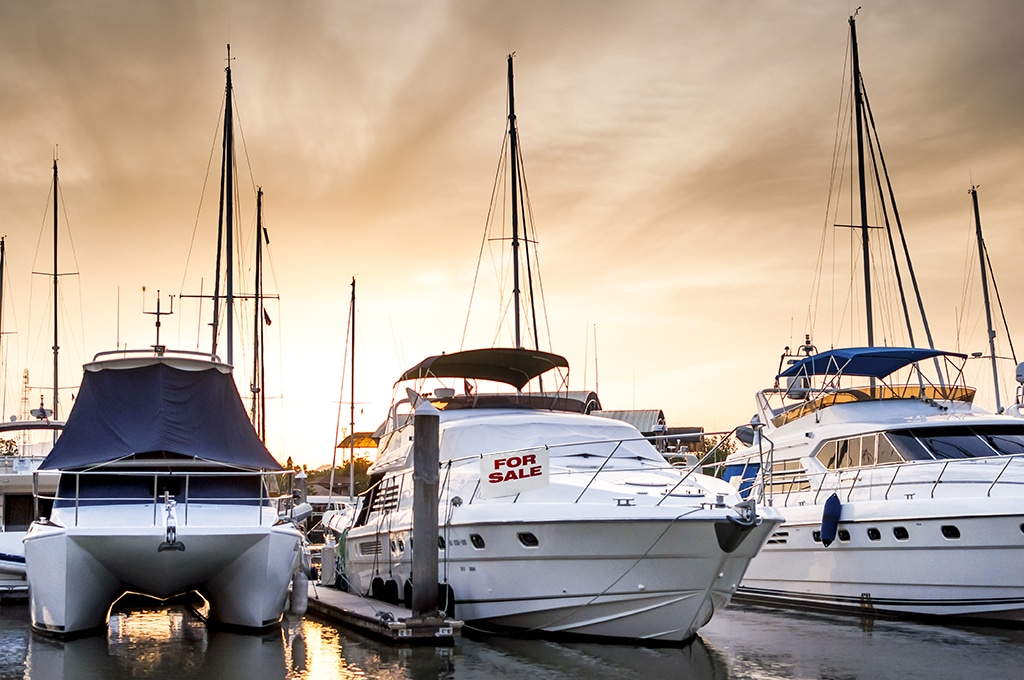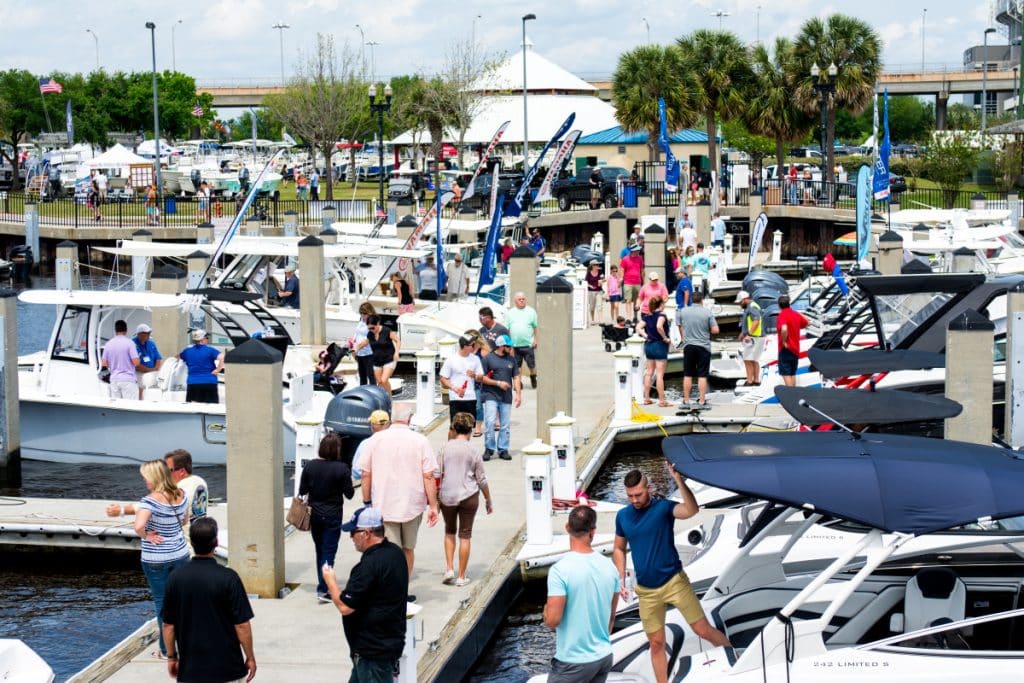A Calculated Investment
A boat is a huge investment that pays dividends in the form of recreational bliss and memorable times spent outdoors with family and friends. But purchasing one is a complicated, multi-party, contractual process, and the decision shouldn’t be taken lightly. Doing your due diligence is the key and ensures an enjoyable and rewarding experience from the get-go, so here are a few of the ins and outs of buying a boat.
How Will You Use It?
Step one is knowing what type of boat best fits your lifestyle. If fishing is your passion, look at center consoles and skiffs. If you enjoy wakeboarding and skiing, then shop ski boats. If you have kids, consider a cuddy cabin for its enclosed cabin (some come equipped with a generator for heating and cooling). Will you sail? Will you primarily use it for cocktail cruises around the lake? Is coastal cruising in your plans? The newer designs accommodate a multitude of personalities and uses, such as a boat that gets anglers out to the grounds quickly, yet has bulwarks that open to create “mini balconies” for entertaining.
Be Sensible and Budget
Costs don’t stop at the dealership. If you neglect to budget for the annual upkeep, you’ll quickly realize there’s truth to those witty B.O.A.T. acronyms like “Bankruptcy on a trailer.”
 undefined
undefinedA buddy of mine was recently in the market for his first boat. During his years-long search, he picked my brain dozens of times about many different makes and models. My tally so far is four: three center consoles and a cabin cruiser big enough to qualify as a second home. Last winter, he called and emphatically claimed he and his wife were ready to pull the trigger on a 35 Regal Sport Coupe. I struggled to keep the alarm out of my voice when I asked what happened to the center console idea. He’s a fisherman. The center console is such a versatile boat, not to mention popular, making it a cinch to sell used. In the end, my friend chose the center console.
He had the financial means to buy the Regal but didn’t give much thought to the upkeep cost. In my home port, Charleston, South Carolina, in-water rental is about $18.50 per foot per month, or $7,800 a year. Add $3,000 for insurance. The watercraft tax is an expense that can sneak up on you. The tax in my state is 10.5 percent. For perspective, the annual tax on a $150,000 boat is about $5,000. Ouch! States like Florida and New Jersey have maximum tax caps of $18,000 and $20,000, respectively, regardless of the boat’s price and size.
Already, the upkeep is upward of $15,000, and I haven’t mentioned other meaty costs such as fuel (marinas typically charge $1 or more per gallon than that at gas stations), annual engine maintenance, haul out fees, bottom cleaning, repairs, etc.
Then there’s depreciation. “Any new boat depreciates immediately the minute it’s sold,” says Ed James, a 30-year broker at Ashley Yachts in Charleston, South Carolina. “In the first year, depreciation can be as much as twenty percent of its value.”
That explains why many boaters buy used. If you’re purchasing used, hire a local surveyor (namsglobal.org), a professional who meticulously inspects a vessel from bow to stern. You’ll pay about $25 per foot, but it’s worth the peace of mind. Unlike new, a used boat usually doesn’t have warranties.
Enlist Help
If you’re in the market for a boat like the Regal, James offers sage advice. “Hire a broker. But take the time to meet with several, and find one you like and get along with. Then let the broker lead the search to find you your boat.” He discourages buyers to go at it alone and to fight the urge to shop online. “What happens is they’ll research boats, find a few they like, then make calls. They don’t realize that the person they’re dealing with is the seller’s broker who’s working to get the best deal for the seller.”
The Finance of Things
Boat prices have skyrocketed in recent years. My proof: In 2013, I paid $58,000 for a brand-new 200 Dauntless Boston Whaler. Today, a similar make and model with an inferior engine sells for about $94,000. The silver lining is that money is cheap. When financing, James recommends using a marine finance company like Sterling Associates or Trident Funding. They specialize in boat loans only and can usually offer better rates than a local bank. Leigh Ackerman, an independent representative for Sterling Associates in Fort Lauderdale, structures loans from $50,000 to tens of millions of dollars. Her most popular loan is the five-year, four-percent fixed with 20 percent down. Banks in my area offer the same term, but rates start at five percent. If you’re wondering what the total savings is on one percent, it’s $1,700! Regardless of the lender, these rates require a good credit score, 700 or higher.
 undefined
undefinedBe wary of salespeople or loan consultants who tout tax savings. If you were one of the many taxpayers who lost the opportunity to itemize last year because of the new tax laws, your savings will be zilch.
When it comes to insurance, take a boater’s safety course. The U.S. Coast Guard Auxiliary offers a wide range of courses for the novice, seasoned, and every boater in between. A great course is “Boating Skills & Seamanship.” It consists of eight two-hour lessons that cover a slew of pertinent topics like boating safety, navigation, and weather and boating. Passing the test not only earns you a certificate, but also a discount on most insurance policies.
Read more: silverton boats for sale
Crunch the Numbers
When you’ve dwindled your search down to two boats, use the net present value method (NPV) to guide you. NPV is a popular business tool used to evaluate investments. It’s preferred because it factors in the time value of money—the idea that the value of a dollar changes over time because it can be invested to earn interest.
To calculate a boat’s NPV, which is easy in Excel, net the cash outflows (purchase price if paying cash, loan amount if financing) against the present value of the cash inflows, e.g., the boat’s future resale value discounted to an amount equivalent to today’s price. The key to discounting a future amount is knowing the discount rate, or loan rate.
Consider the following example. You’re stuck between choosing a 210 Dauntless Boston Whaler and the Grady-White Fisherman 216. The Whaler and Fisherman list for $94,000 and $97,000, respectively. Regardless of the boat, you’re going to finance it and put down $21,000. Standard on the Fisherman is a Yamaha 250-hp outboard. The Whaler has a 200-horse. There’s an option to upgrade to the more fuel efficient 250 Verado for $5,000. You like the extra power, plus the Dauntless’ salesperson believes it could save at least $100 annually in fuel costs.
Both salespeople are eager to sell. The Fisherman’s salesperson will throw in a 12-inch Garmin GPS/fish finder valued at $3,000 (including install) and will take $2,000 off the $4,000 trailer. You’re keen on trailering because it affords you the ability to explore many different waterways. The Whaler folks can knock $1,000 off both the sticker price and the outboard upgrade and offer a five-year loan at four percent. The Fisherman’s dealer uses a local bank that can offer a similar term, but at five percent. In five years, you plan to sell and upgrade to a 24-footer.